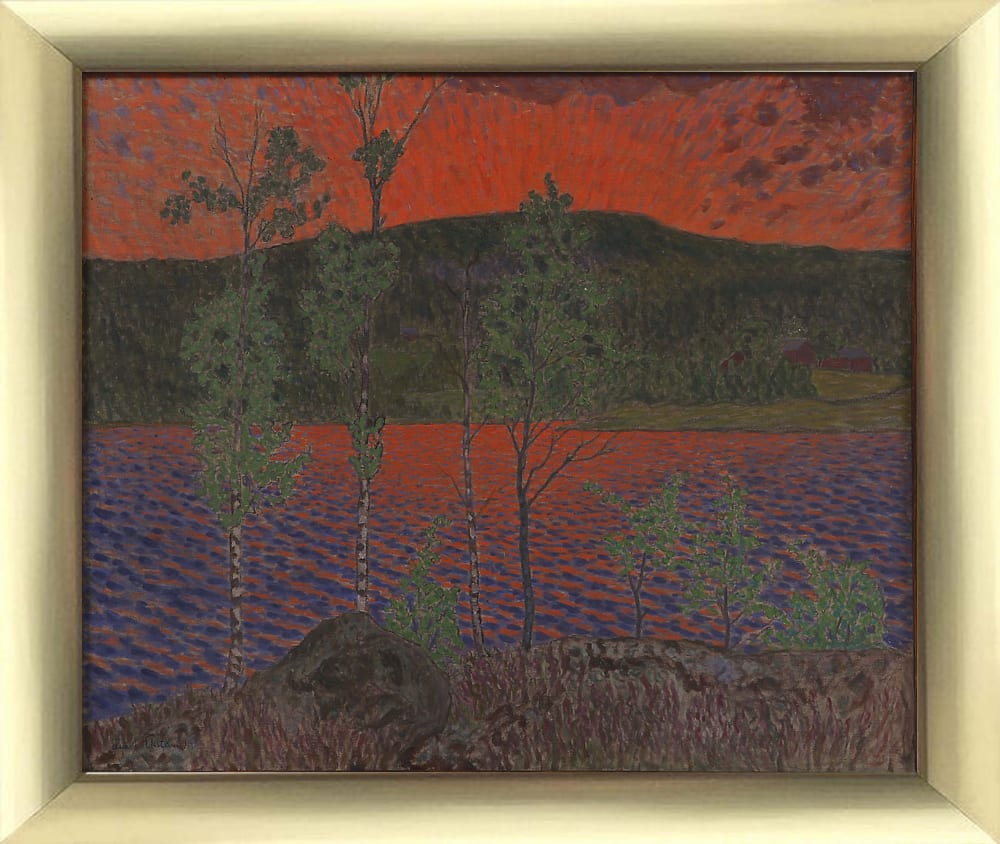

ALFRED EKSTAM MANGSKOG, 1878-1935
SOLD
The painter and craftsman Alfred Ekstam was born in 1878, in a tiny village, called Mangskog, situated in the immensely scenic province of Värmland, just in the middle of Sweden. The region is well known for being the native home of the illustrious novelist Selma Lagerlof, who in 1909 became the first woman and also the first Swedish writer to win the prestigious Nobel Prize for Literature. A peripheral, rural part of the country, bordering Norway, characterised by lush forests that seem to go on forever, interrupted only by innumerable lakes, small open valleys and blueing mountains.
In the same way as the literary culture (the case of Lagerlof) of that specific period in Värmland, enjoyed a particolary symbiotic relationship with the mystic of the nature, so did also the visual arts. In fact here, near to Arvika, the second-generation of Swedish National Romantics formed the Rackstad colony, around the turn of the century, at the very shore of the beautiful Lake Racken, in the midst of the wilderness.
The artists that gathered here shared a need for solitude and peace, cultivating a cooperative lifestyle, influenced by the British Arts and Crafts movements utopian, social ideas[1]. The founders were the artist couple Gustaf Fjaestad (1868-1948) and Maja Fjaestad (1873-1961). Gustaf Fjaestad is today considered the foremost interpreter of the Swedish winter landscape. A pupil of wildlife painter Bruno Liljefors (1860-1939) and former assistent of the nationally loved icon Carl Larsson (1853-1919).
Ekstam himself joined the colony after attending to the Stockholm Technical School.
The intense life in the capital of Sweden was not for Ekstam, who’s identity was too strongly tied to the nature and to the calm of his homeland. In the major part of his life, he worked as a craftsman and a furniture decorator. Highly appreciated by his employers, the Eriksson Brothers Workshop, and therefore soon promoted to become the respected chief decorative painter of the company. His interest for the simple things assumed over time more sophisticated expressions through the painting lessons given to him by Gustaf Fjaestad, Fritz Lindström and the immensely talented Bror Lindh. Another painter that came to influence the shaping of his personal stylistic approach was the internationally awarded Otto Hesselbom (1848-1913). It was after meeting the former that he turned to a Synthesist notion of decorative harmony, focusing his efforts on depicting the local, treasured landscape in a highly decorative manner. Driven by romantic nationalism and aiming to visualise the profoundly mystical sense of his life in the deep forests of Värmland. Although traces and influences of his masters stylistic manners are easily recognisable in Ekstams work, he also developed a strongly personal artistic language, with a strong pointillistic quality. Actually, his production was very limited, since he proceeded extremely slowly, taking amounts of time in completing every work. To note, at the the very first exhibition of his works, in the city hall in Arvika in 1919, as very rarely happens to a debuting artist, all of the paintings in the gallery were sold within a week. A fenomenal success! As said, the artist was strongly anchored with his native place. Consequently the greatest part of his motifs were actually painted in and around Mangskog, where he lived, worked and died at the age of 57, falling of his bicycle on the way to attend an art exhibition.
The present work, is a rare, although representative work by Ekstam, that falls neatly within the artist´s oeuvre. A powerful emotional panoramic landscape, devoid from human presence, but profoundly soulful. The unspoilt forest in the background where, as known, the national Swedish psyche draws its most profound roots. The evening light behind the blueing hills expands violently outwards the universe, in hues of intense carminite red and toxic blu, resembling the visual effect of a volcanic eruption. The same glittering effect sparks over the small lake surface. In the foreground tiny, delicate birches, Swedens national symbol tree, almost seem to tremble in front of the spectacular scenery. The bold approach all together creates a magic radiance, not so peaceful at all! Ones thoughts can’t but go to Edward Munchs tumultuous red skies, which a famous theory actually sustains were inspired by a real volcanic sunset: that after the Krakatau eruption in 1883…
In contemplating the painting nearby, one can’t but admire Alfred Ekstam’s slow technical approach, patiently placing dot by dot in a mosaic-like structure. The French post-impressionist influence, (mainly with George Seurat in thought) in this local motive is certainly evident and present. How long it took for the artist to create this outstanding equilibrium between arts and crafts on the canvas line is not known. Definitely a strongly nationalist Swedish representation, but an irruptive one that reaches courageously toward formidable abstract and modern tendencies. Away from the more traditionally classical approach of his master Gustaf Fjaestad.
The splendid result could be compared to a precious, unique gem, with possible intrinsic magical and spiritual properties. To treasure and keep safe.
[1] Michelle Facos, Nationalism and the Nordic Imagination: Swedish Art of the 1890s, p.187.
Join the mailing list
Subscribe to our newsletter to receive all the news about exhibitions, fairs and new acquisitions!


